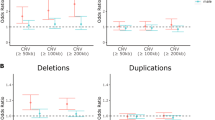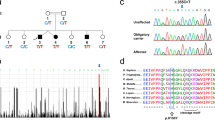Abstract
In children and adolescents, hyperkinetic disorder (HD) with conduct disorder (CD) and without CD and attention-deficit/hyperactivity disorder (ADHD) is known to be comorbid with psychiatric disorders (anxiety, depression, aggression), some of which are related to disturbed serotonergic neurotransmission. The efficiency of serotonergic signalling relates to the concentration of the neurotransmitter in the synaptic cleft and is controlled by the serotonin transporter (5-HTT), which selectively removes serotonin out of the synaptic cleft.1The activity of serotonin transport itself has been shown to be also controlled by a 5-HTT-linked polymorphism in its promotor region with a L/L genotype yielding higher levels of 5-HTT function than do L/S or S/S genotypes.2 Considering an association between 5-HTT polymorphism, serotonergic neurotransmission and HD ± CD, we genotyped for 5-HTT polymorphism and compared patients with controls. In contrast to the distribution of L/L: L/S: S/S in controls (0.245: 0.509: 0.245), we found an enhanced expression of the L/L genotype in HD patients with CD (0.393: 0.304: 0.304; χ2 = 7.603; P = 0.0211) and a significant overexpression of L/L in HD without CD (0.542: 0.333: 0.125; χ2 = 9.127; P = 0.0092). To our knowledge, this is the first finding providing evidence for an association between the 5-HTT polymorphism and hyperkinetic disorder, implying that serotonergic neurotransmission might be affected in this desease. As a consequence, for a successful treatment of these patients one should now also consider drugs which specifically modulate serotonergic signalling such as selective serotonin reuptake inhibitors.
This is a preview of subscription content, access via your institution
Access options
Subscribe to this journal
Receive 12 print issues and online access
$259.00 per year
only $21.58 per issue
Buy this article
- Purchase on Springer Link
- Instant access to full article PDF
Prices may be subject to local taxes which are calculated during checkout
Similar content being viewed by others
References
Schloss P, Williams DC . The serotonin transporter: a primary target for antidepressant drugs J Psychopharmacol 1998 12: 115–121
Lesch KP, Bengel D, Heils A et al. Association of anxiety-related traits with a polymorphism in the serotonin transporter gene regulatory region Science 1996 274: 1527–1531
Pliszka SR . Comorbidity of attention-deficit/hyperactivity disorder with psychiatric disorder: an overview J Clin Psychiatry 1998 59 Suppl 7: 50–58
Wolraich ML, Hannah JN, Baumgaertel A et al. Examination of DSM-IV criteria for attention deficit/hyperactivity disorder in a county-wide sample J Dev Behav Pediatr 1998 19: 162–168
Shekim WO, Kashani J, Beck N et al. The prevalence of attention deficit disorders in a rural midwestern community sample of nine-year-old children J Am Acad Child Psychiatry 1985 24: 765–770
Taylor E, Sandberg S, Thorley G et al. The Epidemiology of Childhood Hyperactivity, Vol 33 Oxford University Press: Oxford 1991
Gillberg C, Carlstrom G, Rasmussen P . Hyperkinetic disorders in seven-year-old children with perceptual, motor and attentional deficits J Child Psychol Psychiatry 1983 24: 233–246
Taylor E (ed) . Syndroms of Attention Deficit and Overactivity Blackwell Science: Oxford 1994
Fishbein DH, Lozovsky D, Jaffe JH . Impulsivity, aggression, and neuroendocrine responses to serotonergic stimulation in substance abusers Biol Psychiatry 1989 25: 1049–1066
Brown CS, Kent TA, Bryant SG et al. Blood platelet uptake of serotonin in episodic aggression Psychiatry Res 1989 27: 5–12
Gelernter J, Kranzler H, Cubells JF . Serotonin transporter protein (SLC6A4) allele and haplotype frequencies and linkage disequilibria in African- and European-American and Japanese populations and in alcohol-dependent subjects Hum Genet 1997 101: 243–246
Lesch KP, Wolozin BL, Estler HC et al. Isolation of a cDNA encoding the human brain serotonin transporter J Neural Transm Gen Sect 1993 91: 67–72
Ramamoorthy S, Bauman AL, Moore KR et al. Antidepressant- and cocaine-sensitive human serotonin transporter: molecular cloning, expression, and chromosomal localization Proc Natl Acad Sci USA 1993 90: 2542–2546
Greenberg BD, Tolliver TJ, Huang SJ et al. Genetic variation in the serotonin transporter promoter region affects serotonin uptake in human blood platelets Am J Med Genet 1989 88: 83–87
Hanna GL, Himle JA, Curtis GC et al. Serotonin transporter and seasonal variation in blood serotonin in families with obsessive-compulsive disorder Neuropsychopharmacology 1998 18: 102–111
Smeraldi E, Zanardi R, Benedetti F et al. Polymorphism within the promoter of the serotonin transporter gene and antidepressant efficacy of fluvoxamine Mol Psychiatry 1998 3: 508–511
Barrickman L, Noyes R, Kuperman S et al. Treatment of ADHD with fluoxetine: a preliminary trial J Am Acad Child Adolesc Psychiatry 1991 30: 762–767
Campbell NB, Tamburrino MB, Evans CL et al. Fluoxetine for ADHD in a young child [letter] J Am Acad Child Adolesc Psychiatry 1995 34: 1259–1260
Findling RL . Open-label treatment of comorbid depression and attentional disorders with co-administration of serotonin reuptake inhibitors and psychostimulants in children, adolescents, and adults: a case series J Child Adolesc Psychopharmacol 1996 6: 165–175
Lange K . Mathematical and Statistical Methods for Genetic Analysis, Vol 4.2 Springer: New York 1997
Williams J, Spurlock G, Holmans P et al. A meta-analysis and transmission disequilibrium study of association between the dopamine D3 receptor gene and schizophrenia [published erratum appears in Mol Psychiatry 1998; 3: 458] Mol Psychiatry 1998 3: 141–149
Mehta C, Patel N . Exact version of Pearson's Chi2 test; implementation by means of StatXact 3 For Windows In: StatXact 3 For Windows. User Manual, Ch 17 Cytel Software Corporation: Cambridge, MA 1996
Stanley B, Molcho A, Stanley M et al. Association of aggressive behavior with altered serotonergic functions in patients who are not suicidal Am J Psychiatry 2000 157: 609–614
Coccaro EF . Central serotonin and impulsive aggression Br J Psychiatry 1989 Suppl: (8) 52–62
Roy A, Linnoila M . Suicidal behavior, impulsiveness and serotonin Acta Psychiatr Scand 1988 78: 529–535
Mann JJ, Malone KM, Psych MR et al. Attempted suicide characteristics and cerebrospinal fluid amine metabolites in depressed inpatients Neuropsychopharmacology 1996 15: 576–586
Stanley M, Stanley B . Postmortem evidence for serotonin's role in suicide J Clin Psychiatry 1990 51: Suppl 22–28; discussion 29–30
Bengel D, Greenberg BD, Cora-Locatelli G et al. Association of the serotonin transporter promoter regulatory region polymorphism and obsessive-compulsive disorder Mol Psychiatry 1999 4: 463–466
Coyette CH, Conners CK . Normative data on revised Conners parent and teacher rating scales J Abnorm Child Psychol 1978 6: 221–236
Heils A, Teufel A, Petri S et al. Functional promoter and polyadenylation site mapping of the human serotonin (5-HT) transporter gene J Neural Transm Gen Sect 1995 102: 247–254
Heils A, Teufel A, Petri S et al. Allelic variation of human serotonin transporter gene expression J Neurochem 1996 66: 2621–2624
Lesch KP, Balling U, Gross J et al. Organization of the human serotonin transporter gene J Neural Transm Gen Sect 1994 95: 157–162.
Author information
Authors and Affiliations
Corresponding author
Rights and permissions
About this article
Cite this article
Seeger, G., Schloss, P. & Schmidt, M. Functional polymorphism within the promotor of the serotonin transporter gene is associated with severe hyperkinetic disorders. Mol Psychiatry 6, 235–238 (2001). https://doi.org/10.1038/sj.mp.4000820
Received:
Revised:
Accepted:
Published:
Issue Date:
DOI: https://doi.org/10.1038/sj.mp.4000820
Keywords
This article is cited by
-
The 5-HTTLPR polymorphism of the serotonin transporter gene and short term behavioral response to methylphenidate in children with ADHD
BMC Psychiatry (2010)
-
Evidence for epistasis between the 5-HTTLPR and the dopamine D4 receptor polymorphisms in externalizing behavior among 15-year-olds
Journal of Neural Transmission (2009)
-
Candidate gene studies of ADHD: a meta-analytic review
Human Genetics (2009)
-
Genetic aspects in attention-deficit/hyperactivity disorder
Journal of Neural Transmission (2008)
-
Serotonin transporter gene polymorphism and the phenotypic heterogeneity of adult ADHD
Journal of Neural Transmission (2007)



